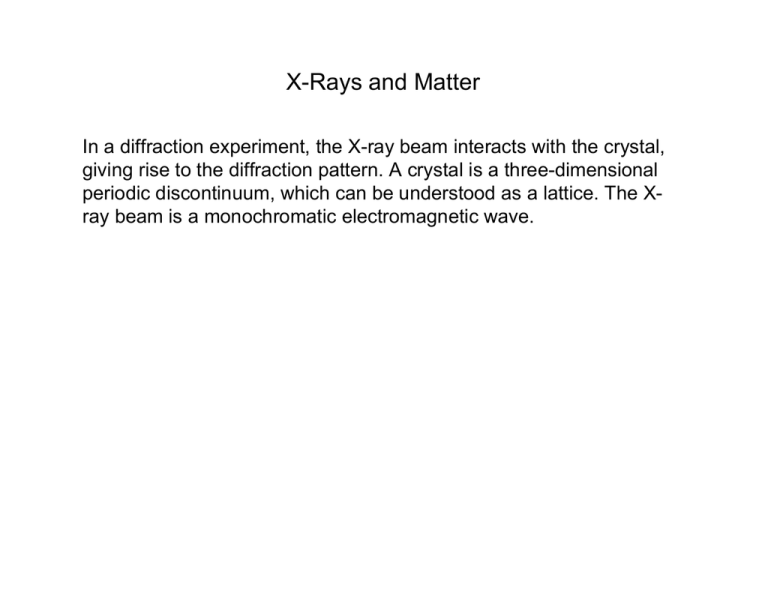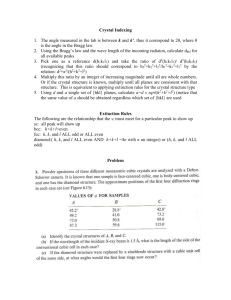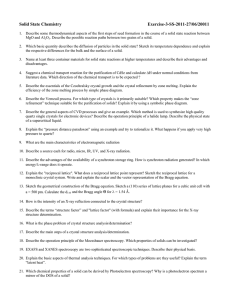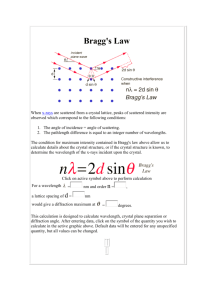X-Rays and Matter
advertisement

X-Rays and Matter In a diffraction experiment, the X-ray beam interacts with the crystal, giving rise to the diffraction pattern. A crystal is a three-dimensional periodic discontinuum, which can be understood as a lattice. The Xray beam is a monochromatic electromagnetic wave. X-Rays X-rays Generating X-Rays Removed due to copyright restrictions. Please see: Massa, Werner. Crystal Structure Determination. 2nd ed. Translated into English by R. O. Gould. New York, NY: Springer, 2004, pp.13. ISBN: 3540206442. Fast electrons Metal (e.g. Mo or Cu) Fig. 3.1 Fast electron Removed due to copyright restrictions. Mo Please see: Massa, Werner. Crystal Structure Determination. 2nd ed. Translated into English by R. O. Gould. New York, NY: Springer, 2004, pp.14. ISBN: 3540206442. Fig. 3.2 K L MN O X-Rays and Matter What happens when a beam of monochromatic electromagnetic waves hits a lattice? One dimensional case: shine light through a optical grid ofdepending parallel Constructive interference happens only at certain angles, lines: on wavelength and lattice constant (spacing between the grid lines). Removed due to copyright restrictions. Please see: Massa, Werner. Crystal Structure Determination. 2nd ed. Translated into English by R. O. Gould. New York, NY: Springer, 2004, pp.17. ISBN: 3540206442. Fig. 3.4 . X-Rays and Matter Diffraction is invariant to translation. But rotation of the lattice rotates the diffraction pattern. X-Rays and Matter Halfing the lattice constant doubles the distance between the spots. X-Rays and Matter Now: Two dimensional case. Shine the laser through a regular array of dots: X-Rays and Matter Removed due to copyright restrictions. Please see: Lisensky, George C., et al. Optical Transform Kit. Madison, WI: University of Wisconsin Board of Regents, Institute for Chemical Education, 1994, pp. 13. Figs. 2-3 Convolution Theorem Diffraction is convolution of the beam (dot or sphere) with the lattice: * = * = Fourier Transformation FT One atom FT FT of one atom FT One molecule FT FT of one molecule Courtesy of Kevin Cowtan. http://www.ysbl.york.ac.uk/~cowtan/ Used with permission. Fourier Transformation FT A lattice FT A lattice of molecules (a crystal) FT of a lattice FT FT Courtesy of Kevin Cowtan. http://www.ysbl.york.ac.uk/~cowtan/ Used with permission. FT of a crystal Reflection on Lattice Planes sin θ = ½∆ d = ∆ 2d θ Bragg’s Law: ∆ = 2d sin θ = nλ d ½∆ θ θ d ½∆ ½∆ Set of parallel planes: Bragg planes lattice X-Rays and Matter What does the wavelength do? nλ = 2d sin θ 3D Bragg Planes: Miller Indices (h, k, l) Removed due to copyright restrictions. Please see: Massa, Werner. Crystal Structure Determination. 2nd ed. Translated into English by R. O. Gould. New York, NY: Springer, 2004, pp. 21. ISBN: 3540206442. Fig. 3.8, 3.9 3D Bragg Planes: Miller Indices (h, k, l) Removed due to copyright restrictions. Please see: Massa, Werner. Crystal Structure Determination. 2nd ed. Translated into English by R. O. Gould. New York, NY: Springer, 2004, pp. 21. ISBN: 3540206442. Fig. 3.8, 3.9 Real Space Æ Reciprocal Space Removed due to copyright restrictions. Please see: Massa, Werner. Crystal Structure Determination. 2nd ed. Translated into English by R. O. Gould. New York, NY: Springer, 2004, pp. 21. ISBN: 3540206442. Fig. 3.8, 3.9 Between the points of a crystal lattice in real space, we have Bragg planes. Each set of Bragg planes corresponds to one reflection. Each set of Bragg planes corresponds to one set of Miller indices. Each reflection is identified by the corresponding Miller indices (h, k, l). The reflections form another lattice, the reciprocal lattice. Real Space Æ Reciprocal Space Removed due to copyright restrictions. Please see: Massa, Werner. Crystal Structure Determination. 2nd ed. Translated into English by R. O. Gould. New York, NY: Springer, 2004, pp. 21. ISBN: 3540206442. Fig. 3.8, 3.9 The vector d is perpendicular to a set of Bragg planes. Its length is equivalent to the distance between two Bragg planes. Each reflection (h, k, l) marks the endpoint of the vector d* = 1/d = s. The length of s is inversely related to the distance between the Bragg planes. The Reciprocal Lattice: Ewald Construction hkl reciprocal lattice point Diffracted beam Detector s Q Incident beam θ θ C hkl reflection P θ s d O Crystal hkl lattice planes Ewald sphere with radius r = 1/λ Reciprocal lattice MIT OpenCourseWare http://ocw.mit.edu 5.069 Crystal Structure Analysis Spring 2008 For information about citing these materials or our Terms of Use, visit: http://ocw.mit.edu/terms.






